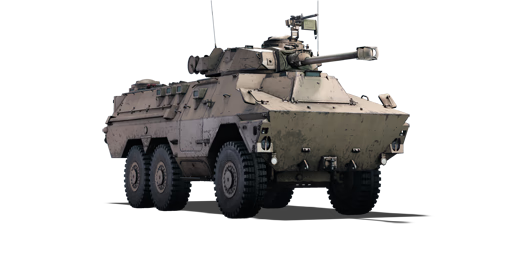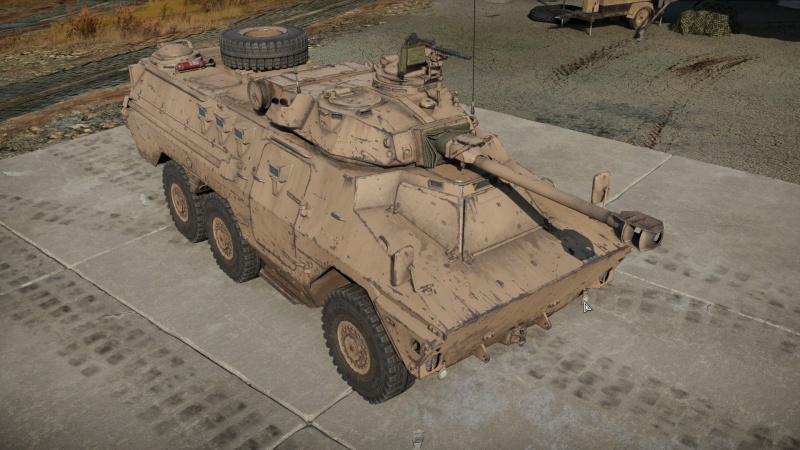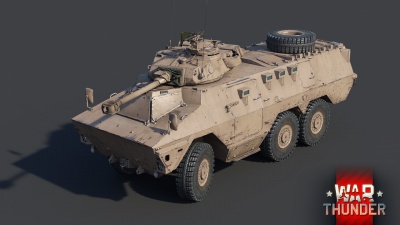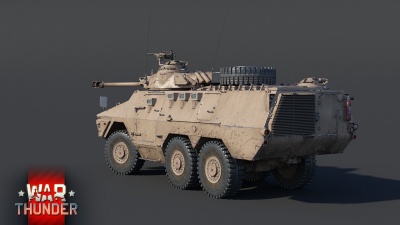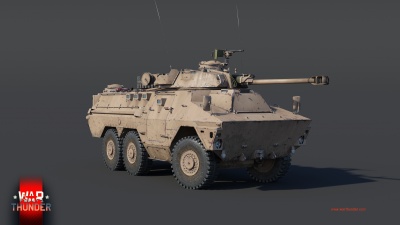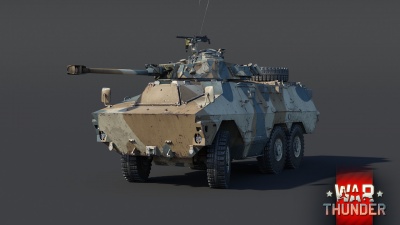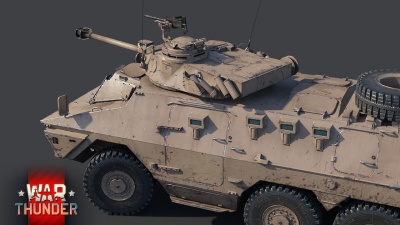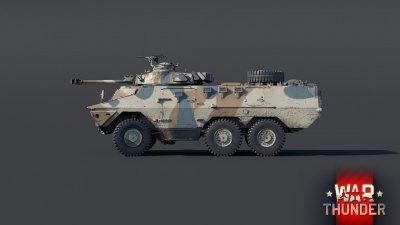Difference between revisions of "Ratel 90"
(Edits) |
(→History: Added devblog history and images) |
||
| Line 187: | Line 187: | ||
The Ratel 90 was designed to be used in the infantry support role but during the South African Border War they were forced into the anti-tank role. Against the initial T-34-85 tanks used by the FAPLA, the Ratel 90 proved to be a very deadly adversary. But once the FAPLA began receiving newer Soviet and Cuban T-54, T-55, and T-62 tanks, the Ratel 90 was forced to use its high mobility to outmanoeuvre the enemy tanks. Once the Ratel 90 was on the flank, they had to fire multiple 90 mm HEAT rounds into the enemy tanks, often aiming for weak points such as the engine and turret ring. | The Ratel 90 was designed to be used in the infantry support role but during the South African Border War they were forced into the anti-tank role. Against the initial T-34-85 tanks used by the FAPLA, the Ratel 90 proved to be a very deadly adversary. But once the FAPLA began receiving newer Soviet and Cuban T-54, T-55, and T-62 tanks, the Ratel 90 was forced to use its high mobility to outmanoeuvre the enemy tanks. Once the Ratel 90 was on the flank, they had to fire multiple 90 mm HEAT rounds into the enemy tanks, often aiming for weak points such as the engine and turret ring. | ||
| − | + | '''Operators''' | |
* South Africa | * South Africa | ||
| Line 195: | Line 195: | ||
* Djibouti | * Djibouti | ||
* Central African Republic (CAR) | * Central African Republic (CAR) | ||
| + | |||
| + | ---- | ||
| + | |||
| + | === [[wt:en/news/7067-development-ratel-90-the-bush-breaker-en|Devblog]] === | ||
| + | In the late 1960s, the South African military began changing its doctrine towards highly mobile warfare, embodied by small mechanized infantry units. The change in doctrine was necessitated when the military realized that heavy armor faced extreme difficulties operating in rural areas of the country. As a result, the army needed a new ICVnot only to ferry troops into battle but also to actively support them in the field. To that extent, a basic requirement for an ICV was formulated and a number of both domestic and well as foreign designs were evaluated. | ||
| + | |||
| + | The domestic Springfield-Büssing company developed a promising six-wheel ICVprototype, called the Buffel, constructed on the basis of a MAN truck. The further developed Buffel prototype was eventually selected for procurement and entered service with the military as the ‘Ratel’. Production of the Ratel began in the mid 1970s, after a limited initial batch of production vehicles successfully underwent testing. Being a family of fighting vehicles, the Ratel came in various modifications, including the base model armed with a 20 mm cannon, two mortar versions, a close fire support variant armed with a 90 mm gun, as well as a command and ATGM carrier modifications. | ||
| + | |||
| + | Ratels served in numerous conflicts since their first introduction in the mid 1970s, with nearly all of its active service taking place on the African continent. The Ratel 90 saw its first combat use in 1980 during the South African Border War, where Ratel 90 anti-tank teams came face to face with T-54/55s on multiple occasions. By the end of production in 1993, some 1304 Ratels were produced across all variants. Due to its simplistic design and perfect fit for the dry climate of sub-Saharan Africa, the Ratel proved at home in the Middle East and north-west Africa. As a result, around a dozen more nations, excluding South Africa, still operate the Ratel ICV. | ||
== Media == | == Media == | ||
| − | <!-- ''Excellent additions to the article would be video guides, screenshots from the game, and photos.'' --> | + | <!-- ''Excellent additions to the article would be video guides, screenshots from the game, and photos.'' --><gallery mode="packed" heights="150"> |
| − | + | File:Ratel 90 WTWallpaper 01.jpg| | |
| + | File:Ratel 90 WTWallpaper 02.jpg| | ||
| + | File:Ratel 90 WTWallpaper 03.jpg| | ||
| + | File:Ratel 90 WTWallpaper 04.jpg| | ||
| + | File:Ratel 90 WTWallpaper 05.jpg| | ||
| + | File:Ratel 90 WTWallpaper 06.jpg| | ||
| + | </gallery> | ||
== See also == | == See also == | ||
Revision as of 03:56, 27 March 2021
Contents
Description
The Ratel 90 is a rank British light tank with a battle rating of (AB), (RB), and (SB). It was introduced in Update "Ixwa Strike".
The Ratel 90 is an IFV designed to provide fire support for the Mechanized South African Battalions in combat. It was modified to this duty with the identical turret found on the Eland 90 Mk.7.
With a needed playstyle keen to recon and opportunistic target eliminations by flanking, the Ratel 90 is currently the fastest vehicle available for the British tree at the rank.
Unfortunately, the vehicle is fast not because of a good engine, but instead because of the cutback of any armour. Players accustomed to holding off some shells in similar ranked vehicles as the Tortoise will have troubles surviving in this IFV. So instead it shall be played similarly to the Charioteer, now with more cooperative abilities as the scouting.
General info
Survivability and armour
Describe armour protection. Note the most well protected and key weak areas. Appreciate the layout of modules as well as the number and location of crew members. Is the level of armour protection sufficient, is the placement of modules helpful for survival in combat? If necessary use a visual template to indicate the most secure and weak zones of the armour.
Armour type:
| Armour | Front (Slope angle) | Sides | Rear | Roof |
|---|---|---|---|---|
| Hull | ___ mm | ___ mm Top ___ mm Bottom |
___ mm | ___ - ___ mm |
| Turret | ___ - ___ mm Turret front ___ mm Gun mantlet |
___ - ___ mm | ___ - ___ mm | ___ - ___ mm |
| Cupola | ___ mm | ___ mm | ___ mm | ___ mm |
Notes:
Mobility
| Game Mode | Max Speed (km/h) | Weight (tons) | Engine power (horsepower) | Power-to-weight ratio (hp/ton) | |||
|---|---|---|---|---|---|---|---|
| Forward | Reverse | Stock | Upgraded | Stock | Upgraded | ||
| Arcade | Expression error: Unexpected * operator. | 437 | Expression error: Unexpected round operator. | __.__ | |||
| Realistic | 249 | Expression error: Unexpected round operator. | __.__ | ||||
Modifications and economy
Armaments
Main armament
The Ratel 90 uses the GT-2, a licensed copy of the French 90 mm DEFA F1 low pressure cannon. The Ratel 90 comes with a stock OCC 60-62 HEATFS ammunition, capable of penetrating most tanks at its BR at any distance. Since the OCC 60-62 is a HEAT-FS shell, most of the damage will be spalling, meaning that the commander must know the opposing vehicle's crew layout and take out the most critical parts and crew members.
| 90 mm GT-2 | Turret rotation speed (°/s) | Reloading rate (seconds) | |||||||||||
|---|---|---|---|---|---|---|---|---|---|---|---|---|---|
| Mode | Capacity | Vertical | Horizontal | Stabilizer | Stock | Upgraded | Full | Expert | Aced | Stock | Full | Expert | Aced |
| Arcade | 53 | -8°/+15° | ±180° | N/A | __._ | __._ | __._ | __._ | __._ | _.__ | _.__ | _.__ | _.__ |
| Realistic | __._ | __._ | __._ | __._ | __._ | ||||||||
Ammunition
| Penetration statistics | |||||||
|---|---|---|---|---|---|---|---|
| Ammunition | Type of warhead |
Penetration @ 0° Angle of Attack (mm) | |||||
| 10 m | 100 m | 500 m | 1,000 m | 1,500 m | 2,000 m | ||
| OCC 60-62 | HEATFS | 320 | 320 | 320 | 320 | 320 | 320 |
| OE 90 F1 | HE | 13 | 13 | 13 | 13 | 13 | 13 |
| Shell details | |||||||||
|---|---|---|---|---|---|---|---|---|---|
| Ammunition | Type of warhead |
Velocity (m/s) |
Projectile Mass (kg) |
Fuse delay (m) |
Fuse sensitivity (mm) |
Explosive Mass (TNT equivalent) (g) |
Ricochet | ||
| 0% | 50% | 100% | |||||||
| OCC 60-62 | HEATFS | 750 | 8.95 | 0.05 | 0.1 | 877.7 | 65° | 72° | 77° |
| OE 90 F1 | HE | 640 | 10.45 | 0 | 0.1 | 945 | 79° | 80° | 81° |
| Smoke shell characteristics | ||||||
|---|---|---|---|---|---|---|
| Ammunition | Velocity (m/s) |
Projectile Mass (kg) |
Screen radius (m) |
Screen deploy time (s) |
Screen hold time (s) |
Explosive Mass (TNT equivalent) (g) |
| OFUM PH90-F2 | 640 | 10.2 | 13 | 5 | 20 | 50 |
Ammo racks
| Full ammo |
1st rack empty |
2nd rack empty |
3rd rack empty |
4th rack empty |
5th rack empty |
6th rack empty |
Visual discrepancy |
|---|---|---|---|---|---|---|---|
| 53 | __ (+__) | __ (+__) | __ (+__) | __ (+__) | __ (+__) | __ (+__) | __ |
Machine guns
| 7.62 mm Browning MG4 | ||||
|---|---|---|---|---|
| Mount | Capacity (Belt) | Fire rate | Vertical | Horizontal |
| Coaxial | 3,600 (250) | 500 | N/A | N/A |
| Pintle | 2,000 (250) | 500 | -10°/+3° | ±120° |
Usage in battles
Describe the tactics of playing in the vehicle, the features of using vehicles in the team and advice on tactics. Refrain from creating a "guide" - do not impose a single point of view but instead give the reader food for thought. Describe the most dangerous enemies and give recommendations on fighting them. If necessary, note the specifics of the game in different modes (AB, RB, SB).
Pros and cons
Pros:
- Great penetration and adequate ballistics; currently the first accessible vehicle in the British ranks with HEAT rounds
- Adequate mobility once fully upgraded (on roads and optimal terrains)
- Scouting, smoke grenades and smoke shells provide great supporting abilities
- Large vehicle size helps with the 90 mm gun recoil
Cons:
- Gun is not stabilized, the vehicle needs to stop to fire accurately; HEAT requires a very precise firing
- Huge size, hard to conceal and difficult to manoeuvre in close quarters
- Very unreliable armour and only 3 crew members; easily destroyed on all angles even with 12.7 mm MG
- Despite good top-speed, acceleration is not great on rough terrain; low power-to-weight ratio (14 HP/t)
- Wheeled configuration and underpowered engine struggles on deep sand and snow
History
The Ratel 90 was based on the Ratel 20 but with significant changes. The main feature of the Ratel 90 is a Denel DT-2 90 mm low velocity gun in the turret from the Eland 90 armoured car. Additionally, the hull roof was reinforced and the amount of troop hatches on top was reduced from four to two. Space for one of the passengers was removed to provide space for more 90 mm ammunition.
The Ratel 90 was designed to be used in the infantry support role but during the South African Border War they were forced into the anti-tank role. Against the initial T-34-85 tanks used by the FAPLA, the Ratel 90 proved to be a very deadly adversary. But once the FAPLA began receiving newer Soviet and Cuban T-54, T-55, and T-62 tanks, the Ratel 90 was forced to use its high mobility to outmanoeuvre the enemy tanks. Once the Ratel 90 was on the flank, they had to fire multiple 90 mm HEAT rounds into the enemy tanks, often aiming for weak points such as the engine and turret ring.
Operators
- South Africa
- Morrocco
- Ghana
- Rwanda
- Djibouti
- Central African Republic (CAR)
Devblog
In the late 1960s, the South African military began changing its doctrine towards highly mobile warfare, embodied by small mechanized infantry units. The change in doctrine was necessitated when the military realized that heavy armor faced extreme difficulties operating in rural areas of the country. As a result, the army needed a new ICVnot only to ferry troops into battle but also to actively support them in the field. To that extent, a basic requirement for an ICV was formulated and a number of both domestic and well as foreign designs were evaluated.
The domestic Springfield-Büssing company developed a promising six-wheel ICVprototype, called the Buffel, constructed on the basis of a MAN truck. The further developed Buffel prototype was eventually selected for procurement and entered service with the military as the ‘Ratel’. Production of the Ratel began in the mid 1970s, after a limited initial batch of production vehicles successfully underwent testing. Being a family of fighting vehicles, the Ratel came in various modifications, including the base model armed with a 20 mm cannon, two mortar versions, a close fire support variant armed with a 90 mm gun, as well as a command and ATGM carrier modifications.
Ratels served in numerous conflicts since their first introduction in the mid 1970s, with nearly all of its active service taking place on the African continent. The Ratel 90 saw its first combat use in 1980 during the South African Border War, where Ratel 90 anti-tank teams came face to face with T-54/55s on multiple occasions. By the end of production in 1993, some 1304 Ratels were produced across all variants. Due to its simplistic design and perfect fit for the dry climate of sub-Saharan Africa, the Ratel proved at home in the Middle East and north-west Africa. As a result, around a dozen more nations, excluding South Africa, still operate the Ratel ICV.
Media
See also
- Vehicles with similar chassis
- Related service history
- Similar playstyle
External links
Paste links to sources and external resources, such as:
- topic on the official game forum;
- other literature.
| Britain light tanks | |
|---|---|
| A13 | A13 Mk I · A13 Mk I (3rd R.T.R.) · A13 Mk II · A13 Mk II 1939 |
| A15 | Crusader II · Crusader "The Saint" · Crusader III |
| A17 | Tetrarch I |
| IFV | Warrior · Desert Warrior (Kuwait) |
| Wheeled | Daimler Mk II · AEC Mk II · Fox · Vickers Mk.11 |
| Other | VFM5 |
| South Africa | |
| SARC | SARC MkIVa · SARC MkVI (2pdr) · SARC MkVI (6pdr) |
| Ratel | Ratel 90 · Ratel 20 |
| Rooikat | Rooikat Mk.1D · Rooikat 105 · Rooikat MTTD |
| Other | Concept 3 · Eland 90 Mk.7 |
| USA | Stuart I · Stuart III |


